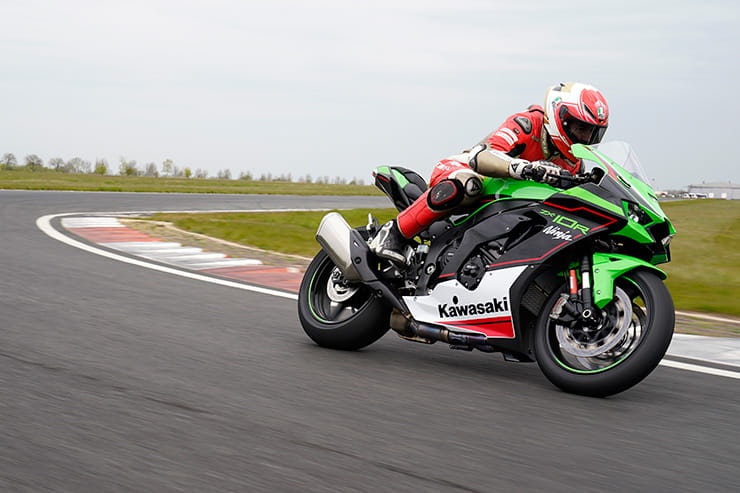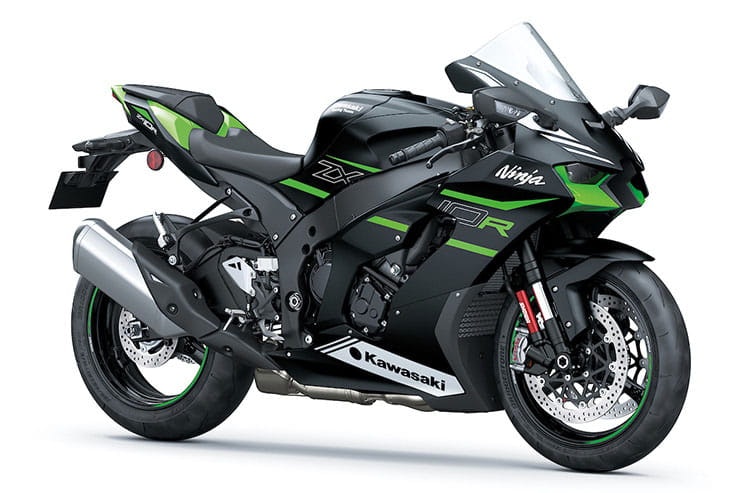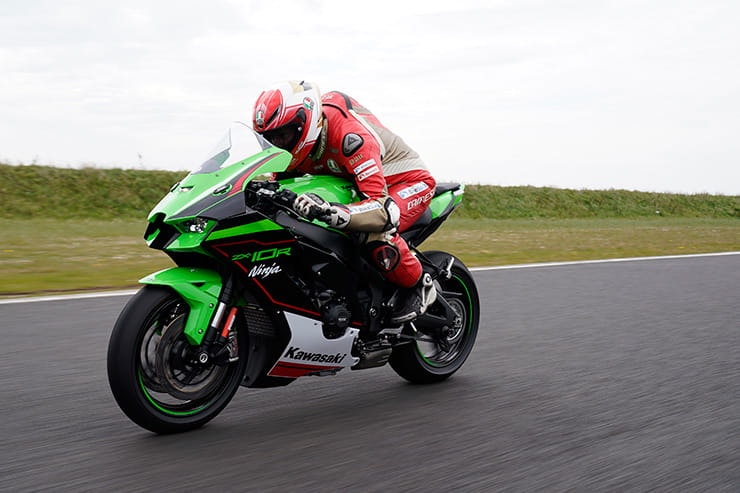Kawasaki Ninja ZX-10R (2021) - Review
By Michael Mann
BikeSocial Managing Editor
30.04.2021
Kit list
Leathers
Dainese D-air Racing Mugello, £2,799.95 | www.dainese.com
(Custom fit and personalised via Dainese Custom Works)
Gloves
Dainese Full Metal 6, £299.95| www.dainese.com
Boots
Dainese Axial D1, £519.95 | www.dainese.com
While it could be argued that too much is made of peak horsepower figures from today’s superbikes (we all know that kind of power is unusable on public roads), a switch of emphasis was on the cards for the keyboard warriors and their notebooks full of derogatory terms when the 2021 Kawasaki Ninja ZX-10R and RR was unveiled. Though I am certain opinions on the bike’s aesthetics won’t bother Jonathan Rea one bit. So long as the six-times World Champion is at the front of the World Superbike grid I doubt he’d care if his bike looked like the back end of a horse. Then again, he doesn’t have to spend his own money on it. Of course, praise and compliments are seemingly forbidden on social media.
But hang on. We interviewed Craig Watson from Kawasaki UK on the day the two bikes were unwrapped back in November, we then posted a walkaround video on our Facebook channel of the bike at this press launch, and the appearance drew plenty of appearance commendations. Faith is restored… for a short while.
Joking aside, other than the marmite-ness of the appearance of the drag reducing design work taking over the whole bike, also new for the 2021 Ninja ZX-10R model is the riding position, a taller screen, electronic tweaks, a new oil cooler, a new exhaust system and amended gearing, much of which is designed to meet Euro 5 regulations while enhancing comfort, control and performance. Although, they’ve not gone overboard because Project Leader, Matsuda-San, says, “if you don’t need it, you don’t get it”. Expect cruise control. That’s seemingly a necessity on a litre sportsbike.
Meanwhile, on the limited-edition RR machine designed with out-and-out racing or track day heroics in mind, the engine is the focus of more significant changes. A 500rpm higher rev limit at 14,700rpm in-line with WSBK regulations. To gain more performance out of the engine they’ve gone for a full Pankl set-up with matching pistons, connecting rods and pins. It also has RR-specific camshafts. The RR also comes with 7-spoke Marchesini forged wheels bespoke to this model.
The last dramatic change for the firm’s flagship sportsbike was 2016 and the one before that was 2011 so history would suggest Kawasaki offer a significant update every five years. That regular evolution doesn’t include the RR which was launched in 2017 following a request from the World Superbike race team to allow for more space for higher lift cams in race spec. It was then upgraded in 2019 because of the WSBK regulations where the Japanese manufacturer went for the Pankl lightweight titanium rods allowing for faster change of direction, later braking and faster revving. It obviously worked, just ask Mr Rea.
Back to 2021 and the ZX-10R. We were among the few invited to the Bedford Autodrome and its South-West circuit layout for many happy laps on the new Kawasaki with Lee Jackson and Rory Skinner, FS-3 Racing’s (the official factory Kawasaki team) line-up for the Bennetts British Superbike season ahead, watching on.
Low down engine performance and those closer ratios
Suspension that makes you think it’s semi-active
Slick and precise quickshifter and autoblipper
Confident handling
Small TFT
Lack of fuel gauge
Switchgear could be easier to use
Foot pegs are very high for any kind of road use
Kawasaki Ninja ZX-10R (2021) Price
How much is the 2021 Kawasaki Ninja ZX-10R? For the base spec R then you’ll be shelling out £15,799 but opt for the Performance Edition fitted with an Akrapovic silencer and seat cowl for an extra £1000, up to £16,799. The green machine will be in dealerships from May 2021 and is available in two colours; Lime Green/Ebony/Pearl Blizzard White (bit like the WSBK) or Flat Ebony (black).
Then for the very limited RR, you’re looking at £24,799 or just an extra £800 for the Akrapovič-equipped Performance Edition at £25,599 though the initial supply is dedicated to race teams ahead of the 2021 BSB and WSB seasons. It’s only available in Lime Green, which I prefer to the R’s scheme.
Here’s a PCP example for your perusal:
Power and Torque
Like I said, it’s not always about peak power and torque, it’s about how it’s applied and controlled. On paper the ZX-10R and despite having 200bhp+ next to its name, it still falls below its nearest competitors but when ridden back to back, those sort of figures would be barely noticeable. On the Bedford Autodrome’s SW layout, there’s the benefit of some longer sweeping corners, a couple of hard braking zones into sharper turns and then a mega, long, top-gear straight where 175mph can be achieved. Coming out of a slower second-gear left that opens gradually onto that back straight offers a chance to explore mechanical and tyre grip, chassis balance, suspension settings and the audio coming from the airbox gulping in huge breaths while the exhaust sang an appealingly raucous note. All while the throttle is pinned and the bike sits skilfully stable. It picks up from the lower revs noticeably better than the previous generation and then barrels quickly towards the 13,200rpm red line. Too quickly for me on a couple of occasions… #limiter. Any performer able to pump out a double tonne of horses is going to be invigorating but, as Pirelli said back in ’94, ‘power is nothing without control’ thankfully for all the throttle and tyre bullying I dished out, I could almost hear Kawasaki’s engineers egging me on to try harder.
I was going to make this point in the next section but for all the commendable engine revisions to comply with the latest set of emission regulations, and for all the power the 998cc four-cylinder has to offer, I couldn’t help feel its restrictions. Like a caged lion crying to be set free. And that’s where World Superbikes and British Superbikes step in to offer that release.
Above: the RR is in lime Green but the R comes in the race colours or black
Engine, Gearbox and Exhaust
Manufacturers are really earning their dollars with Euro 5 compliance by maintaining (or sometimes enhancing) performance while still offering a cleaner engine. Kawasaki’s take on it has been to furnish the 998cc inline four cylinder-powered motor some new components. Namely a WSBK-derived air-cooled oil cooler, repositioning of a catalyser to heat up faster, shortening the first three gear ratios plus larger rear sprocket (up from 39T to 41T) for quicker acceleration. And however those small those amends sound, it’s made a vast difference in the way the engine spins up and offers much better performance in to and out of slower corners. In Sport mode the bike delivers its full power though I rode most of the day with the traction control on its lowest setting which still offered enough intervention to prevent the rear from sliding. The faster and more controllable acceleration will be an immense upgrade for any road-riding ZX-10R owner.
Gearbox-wise, the new ratios make a positive difference to make the bike much more rideable on the roads but also to drive out of those slower corners, although first gear will still take you beyond 90mph. With the digital rev counter flies toward the red zone at 14,000rpm, and you keep feeding the gears in with that superb quickshifter that clunks deliberately at 100% throttle yet is super smooth at lower rpm. Interestingly there didn’t appear to be a hard limiter in fifth and while I played with short-shifting in places, much like the V4’s of some rivals, the Kawasaki has plenty of torque to offer competitive pull when it’s easier to leave it in a higher gear. I did notice a small lurch forwards when rolling off mid-corner but barely worth writing about.
The standard-fit silencer might not be a beauty, but it sure does sound good. I’m not sure I’ve heard an inline four-cylinder growl as much, but Kawasaki have increased the length of it by 126mm and increased the volume as part of that emission clean-up operation.
Much like the latest derivative of the Honda Fireblade, the ZX-10R is a racing thoroughbred with many components shared with the RR version which will be competitive in the Superstock classes around the globe. That of course makes it at home on the track and while we didn’t get to ride on the roads, I’d certainly recognise the gearbox amends would make it more suitable than the previous generation.
Kawasaki Ninja ZX-10R (2021) Comfort and Economy
Ah, a section of the standard review template not necessarily designed for sportsbikes but with the handlebar and chassis adjustments in mind, I found my upper half with just the right amount of room in which to move around the bike and get tucked in as much my unfit 6ft/14st frame would allow. The higher pegs offer loads of ground clearance at lean and promote an athletic and aerodynamic position with which one can man-handling the bike. The gearshift is ideally placed and how’s this for attention to detail… Mr Rea asked for the rear brake reservoir to be moved so the rider could move their boot around more freely.
My only gripe about the comfort, and it was exaggerated when sitting on Rory Skinner’s FS-3 race bike on display in the pit garage, was the angle of the brake and clutch lever. Adjustable I’m sure but a little too high in its standard location for me.
I’ll glaze over the economy section on the basis this was a track-based test though the manufacturer claims a hefty return of 47mpg, so with a 17-litre tank that would, in theory return a barely believable range of 170-miles.
Handling, Suspension and Weight
Despite lacking the blatant winglets that many of its rivals have sprouted, there are aerodynamic surfaces hidden behind the fairings either side of the headlights, creating a claimed 17% more downforce than the previous design. What’s more, the nose reduces overall drag despite being less pointy than its predecessor, with a noticeably taller screen to let riders tuck in better. A welcome benefit.
Even the back of the bike, which looks much the same as before, is actually new. There are slots in the sides of the tail to let air through, further reducing drag, while the side panel changes improve aero efficiency and help guide engine heat away from the rider.
Looking at the bird-like beak, Kawasaki didn’t just offer a competition winner the chance to design the front end, this is the company that designed the Japanese Bullet train, they have one of the world’s best wind tunnels, and they have an engineering department dedicated to aerodynamics – they know how to make things go fast. And while competitors have blue-tacked some appendages onto existing fairings, Kawasaki have designed an entire ‘wing’ that is the front end of the bike that increases downforce yet has less drag than the old bike. Could I tell? Well, without the benefit of a back-to-back test what I can say is that the application of full throttle at corner exit didn’t promote any form of instability or indeed wheelie. Hard on the brakes and once again the Kawasaki kept calm and under control. With confidence building each lap, I’d push a little more with the front’s grip and then show a little more keenness to get on the throttle earlier and yet the bike was smooth in the transition with no head wobbling. It’s one of the most manageable sportsbikes I’ve ridden.
It’s not just the fairings that affect the aero of a bike. The lump controlling throttle inputs has a fair say too which is why the revised riding position is a blessing. Plenty of room to shove your bum back against the pillion seat and enough room under that screen which with its erectness almost looks like a TT machine’s.
Kawasaki Ninja ZX-10R (2021) Brakes
Aerodynamics of a bike of course help the thing slow down in a more controlled fashion too. With a pair of 330mm Brembo semi-floaters being gripped by M50 monobloc calipers, the Kawasaki stops well without an obscene about of lever pulling and I didn’t have the thing waggling its tail in the braking zones either. The ABS didn’t play too much role despite Bedford’s bumps which I thought might upset the system. I am a hard braker and never once ran out of road so even though the braided steel lines were saved for the more race-focused RR version, these more road-compliant rubber version still have enough more than enough power.
Above: got a session on the more race-focussed RR
Rider aids
Refreshingly understated, the ZX-10R isn’t a bike like so many perhaps sexier rivals with an encyclopaedia full of acronyms and settings. Three pre-set rider modes and then four manual versions for you to set the power (Full, Medium or Low) or traction control (off/1/2/3/4/5) yourself. Riding modes can be changed while riding but only with a closed throttle. In a way, it’s a shame there’s no Race mode to offer the ability to tinker with wheelie control or ABS.
The IMU (Inertial Measurement Unit) works on a 6-axis specification while the yaw rate is calculated by the ECU. Essentially the brain of the bike is working overtime below you while everything appears more serene on top with sensors picking up measurements of traction control, ABS, engine brake control and launch control. Cruise control is new for 2021 and operational from the left bar. Also new is the 4.3” TFT display; it was an absolutely necessary upgrade for this generation but still a little underwhelming. OK, I get the ethos of ‘if you don’t need it, you don’t get it’ and while the font and layout makes it very easy to read, I can’t help but think how dated it already looks compared to others.
On the plus side, the Kawasaki RIDEOLOGY app is compliant to check vehicle info, riding log, phone notifications and even riding mode changes.
Rivals
While the sensible move might have been to list the more, er, standard versions of the following machines, I’ve gone large and picked the top spec bikes instead which are more in line with the RR but have the benefit of not being limited to 500.
For the R’s competition then look no further than the lower spec versions of the above.
Kawasaki Ninja ZX-10R (2021) Verdict
A tremendous amount of effort has gone into making the R a much, much better bike than its predecessor and much of that transformation might not be immediately evident at first glance. It comes into a class laden with sophisticated competitors from Japan and Europe but as a pure rider’s bike, the ZX-10R is a real step up and offers performance and track-capability at a noticeably handy price. The engine pulls really well from lower revs thanks to those re-worked ratios, while the suspension and brakes work harmoniously, the chassis and ergonomics offer an aggressive yet manageable and rewarding experience too. It lacks the allure of some more glamorous rivals, weighs at least 5kg more than most and I’m not wild about the switchgear and TFT screen but overall, the Kawasaki packs a punch, is easy to ride, immensely stable, and extremely proficient on track and will be up there once again in race form challenging for the wins.
Kawasaki Ninja ZX-10R (2021) Technical Specification
Photos by Tim Keeton / Impact Images
Video by Giggabox
What is MCIA Secured?
MCIA Secured gives bike buyers the chance to see just how much work a manufacturer has put into making their new investment as resistant to theft as possible.
As we all know, the more security you use, the less chance there is of your bike being stolen. In fact, based on research by Bennetts, using a disc lock makes your machine three times less likely to be stolen, while heavy duty kit can make it less likely to be stolen than a car. For reviews of the best security products, click here.
MCIA Secured gives motorcycles a rating out of five stars, based on the following being fitted to a new bike as standard:
A steering lock that meets the UNECE 62 standard
An ignition immobiliser system
A vehicle marking system
An alarm system
A vehicle tracking system with subscription
The higher the star rating, the better the security, so always ask your dealer what rating your bike has, and compare it to other machines on your shortlist.


